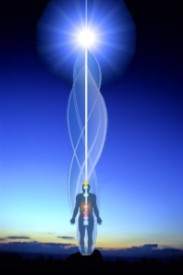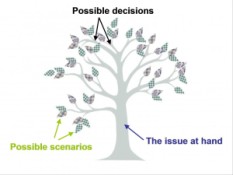In a previous post, we learned that all of us have pre-planned not just one, but 3-5 exit points (“termination junctures”) spread out over our lifetime. The decision to leave early or to stay till the end of the planned lifetime is made by our soul (aspect) on the energetic side, not by the ego on the physical side. What happens in our life review after death?
What happens during the dying process?
As Guy Needler has told us, the soul/aspect that was animating the body has to squeeze its energies out of the body to return to its True Energetic Self/Oversoul (“Home”), which exists higher up in the multiverse, not in the physical universe, where all incarnation takes place.
- The personality of the aspect knows how to leave the body at will before its demise, but only if the person is conscious enough to make that decision (not sedated etc.).
- The energies first move to the Tan tien (below, left), then slowly up along the Hara line to shoot out of the crown chakra to join the True Energetic Self (right) in the third or fourth full dimension in the multiverse for most souls incarnated as humans.
When the soul leaves the constraints of the physical body, the sensation varies from being pulled out (from the top of the head or head and chest) to sinking or instantly blinking into another reality. The experience can be a complete blank or a tunnel effect (ascending the Hara line) or a sudden expansion and knowingness, depending on your level of consciousness.
What happens in our life review after death?
Most of us have heard of a “life review” that the soul undergoes after death, as reported by Michael Newton and others. But Needler said the review process is way more complicated than what we’ve been told in the past, because it involves our entire “tree of life.”
What is our tree of life?
Most people don’t realize that we (as incarnate beings) exist in multiple versions, like a team of egos or “local you’s” in multiple parallel environments within event space, which allows us to maximize our learning about the cause and effect of many things in a single lifetime.
- Our lives are created from a series of choices, which occur in every now moment. But we don’t play out just one scenario represented by a single line (below, left).
- We play out ALL the possible “what if scenarios” in event space, which expands and contracts in a fractal pattern like a tree with branches created by our choices (right).
- A strong intention creates a thick branch. But indecision or changing your mind creates a thin branch or an evolutionary dead end, when you lose interest in that scenario.
You’re constantly “jumping timelines” or shifting your consciousness from one localized event space to another. But eventually all the branches merge back to the main trunk, which is the main direction of your life planned for this particular personality, body, era or setting.
How does this affect our life review?
After the soul (aspect) leaves the physical vehicle, it undergoes a “debriefing” or life review process at the frequency level that its True Energetic Self (TES) exists within. It is a very comprehensive process that takes a long, long time to complete. Why? Needler explained:
- It involves not only the soul (aspect), but its guides, helpers and the TES, who all work together to understand how the life went and how well they worked together.
- The review doesn’t just look at the linear existence that we had, but also includes all the different fractalized, localized parallel conditions that happened in event space (see How Detailed Is the Soul’s Life Review? – Big Picture Questions.com).
Image analogy: Soul/aspect (owner) walking with its team of incarnate selves (dogs). Each self is exploring different scenarios, but some are more aligned with the aspect than others.
That means looking at what went ‘right,’ what went ‘wrong’ (disharmonious conditions), and understanding how we sorted something out in one parallel condition but not in another one.
- The team of parallel you’s exploring different event spaces could range from hundreds to hundreds of thousands in some stages of your life, which all need to be understood.
- When all of the event spaces re-converge to the mainstream, the evolutionary content of that particular life is complete. The life review continues until this convergence happens.
The aspect may wish to carry over some parts of the life to a new incarnation, to learn more in another set of circumstances or environment, according to Needler.
What is the life review environment like?
The newly disincarnate person may realize they’re dead, because their physical form is dead, but they may still think in terms of human forms. Most of the literature derived from hypnotic regression, NDEs, etc. describe the human perspective projected to the afterlife. For example:
- The soul/aspect may recognize other entities (e.g. relatives, guides, helpers, etc.) by their energetic signature, but they may still paint a human form around them, based on their familiar appearance on Earth.
- They may create an earth-like environment for themselves (e.g. healing/resting place, library, school, room with robed beings sitting at a table, or a movie theater or studio setting to replay various scenarios from the point of view of the aspect and others, etc.).
- Those aspects that incarnated in other parts of the physical universe as alien species or forms would paint beings and environments matching their world at this stage.
Needler said the True Energetic Self already knows and has experienced all these event spaces, but the soul is trying to understand them better. Eventually, the soul starts to realize that these environments and human forms are false, and that their true condition is a purely energetic state, which gives them a completely different perspective and functionality.
When do we commune with our True Energetic Self?
During the review process, the aspect remains temporarily disassociated from their True Energetic Self. But at some point the aspect goes through a personal review with the TES and a “cleansing process” to remove any disharmonious energies before reintegrating with it.
There are two forms of communion with the True Energetic Self (see How Does Reincarnation Work? – Big Picture Questions.com):
1. Total communion:
The aspect’s energies move back into the TES, where it becomes like a drop of water in the ocean. Initially, it will have massive memory sets of all that the aspect itself has done. Then it becomes dissolved in the greater memory set of everything that is the TES.
2. Partial communion:
The aspect maintains its sentience and individuality, while it is in a level of communion or integration with the TES.
- Some aspects tend to be specialized in certain experiences, functions and abilities, so they tend to stay as individualized sentience within their TES.
- They can be called upon to do other incarnations with those abilities in a more efficient way than less experienced or brand new aspects.
Nanci Danison (“Backwards”) said it was like being home, feeling completely fulfilled and at peace and whole again with full access to Universal Knowledge.
“We understand fully that we are literally extensions of Source’s awareness and consciousness, that we have never been separate from Source, and that human life was something like an illusion or role we played in a dream…
We have a wealth of abilities unknown to humankind. We are telepathic. We move freely in all directions and have expanded senses. We have total recall of every detail of physical lives lived, including all the sensory data collected. We are able…to share our consciousness intimately with other Beings of Light through merger with them, thereby residing in a simultaneous joy of individuality and collective being.” – Nancy Danison
Note: We will learn a lot more about the afterlife experience in Needler’s upcoming book (“The Anne Dialogues“) about his communications with his late wife, who as a former scientist can describe the energetic side in terms that will demystify much of the process for us. 🙂
Picture of you zooming toward the light…by Mark Parisi












